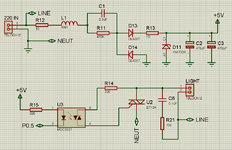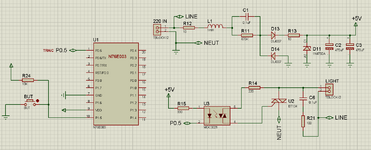gauravkothari23
Advanced Member level 2
Hi all.
I am trying to build a small circuit where i need to switch ON and OFF and 220V AC Light using 8051 Controller.
Circuit Diagram attached.
I am using BT134 Triac to control the Light and MOC3021 to drive the triac.
Have connected the MOC3021 to Controller Pin P0.5.
My Problem is when i try to switch OFF the lights, the output does not gets completely zero. it shows me output voltage of approx 50 to 60V AC and also the light stays dimming.
can anybody please let me know where the issue is.
The same triac BT134 when i replace it with BT136 Triac, the things work well.
I am trying to build a small circuit where i need to switch ON and OFF and 220V AC Light using 8051 Controller.
Circuit Diagram attached.
I am using BT134 Triac to control the Light and MOC3021 to drive the triac.
Have connected the MOC3021 to Controller Pin P0.5.
My Problem is when i try to switch OFF the lights, the output does not gets completely zero. it shows me output voltage of approx 50 to 60V AC and also the light stays dimming.
can anybody please let me know where the issue is.
The same triac BT134 when i replace it with BT136 Triac, the things work well.

